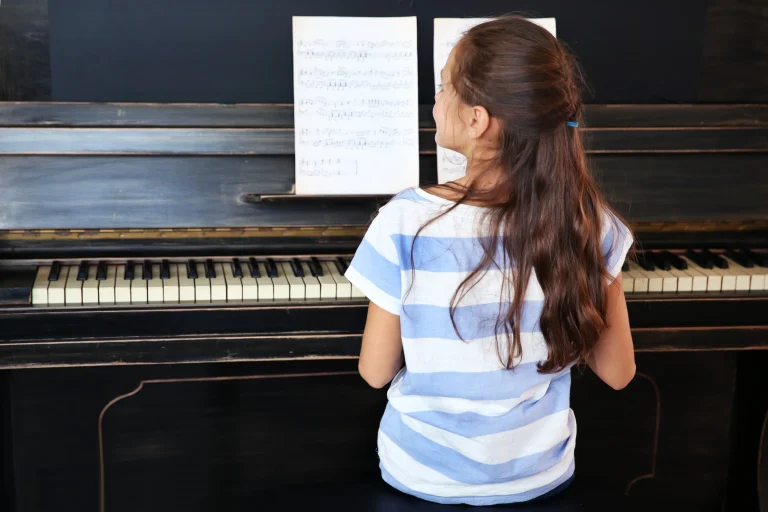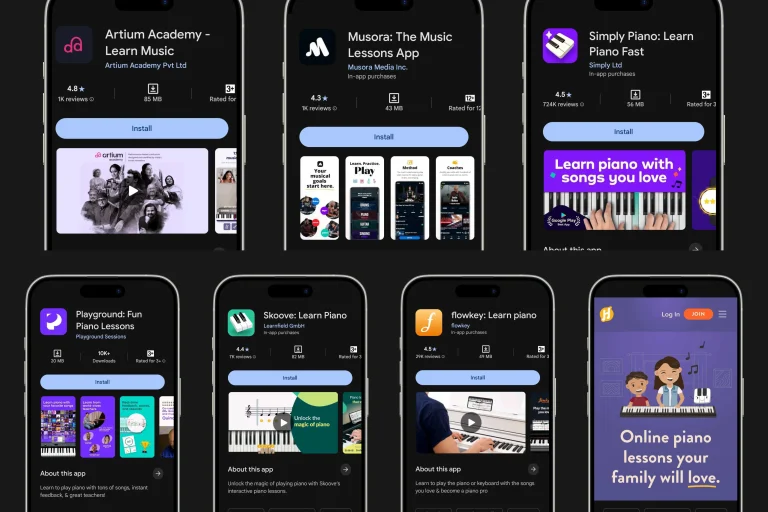All Topics
- Alchemizing Music Concepts for Students
- Artist Spotlight
- artium gift card
- Artium Maestros
- Artium News
- buying guide
- Carnatic Music
- Devotional Music
- Editorials by Ananth Vaidyanathan
- Film Music
- Guitar
- Hindustani Classical Music
- Indian Classical Music
- Indian Folk Music
- Insights
- Instruments
- Karaoke Singing
- Keyboard
- Kids Music
- maestros
- Music Education
- Music for Kids
- Music Industry
- Music Instruments
- Music Legends
- Music Theory
- Music Therapy
- Piano
- piano guide
- Success Stories
- Tamil Film Music
- Telugu Film Music
- Time Theory
- Tools
- Uncategorized
- Vocal Singing
- Vocals
- western classical music
- western music
- Western vocal music
5 Easy Piano Duets for Beginners: Learn to Play in Perfect Harmony
5 Easy Piano Duets for Beginners: Learn to Play in Perfect Harmony

Table of Contents
For those starting their piano lessons, we know how it may feel.
A sense of excitement, curiosity, and nervousness is bound to take over. But you know, there is a better way of learning piano than doing it alone, and that is by playing piano duets. Imagine sitting next to a friend, family member, or teacher, playing together with both hands moving in harmony to produce beautiful, shared music on one piano.
Now, that is something special, and that is the magic of piano duets.
If you are new to the idea of playing piano duets or want to find easy piano duets for beginners, then you have come to the right place. In this guide, we will break down everything you need to know about what piano duets are, why they benefit beginner players, and popular easy duet songs you can start playing right away.
Let’s get started on this piano learning journey together.
What are Piano Duets?
In simple words, the piano duets are pieces of music written for multiple pianists to sit together and play on a single piano.
So, don’t be surprised if you hear the term “four-hand piano duets”. It simply means there are four hands at work on the piano at once. And don’t confuse it with a piano duo, because it means there are two pianos and two people playing the piano.
Duets are primarily divided into two sections –
- Primo – Is usually the first player. They typically take the melody, the main tune you hear, which is often simpler to play.
- Secondo – Is the second player providing accompaniment, which includes chords, bass lines, and rhythm, supporting the melody.
Some pieces alternate these roles or share the melody, but most beginner duets assign primo and secondo parts to facilitate easier coordination.
What Should You Know About Piano Duets for Beginners?

Now, if you are a beginner about to start your piano learning journey, then doing duets is better than solo pieces. And we have the following reasons why piano duets may be fantastic for beginners –
- Develop rhythm and coordination – Listening is one of the most invaluable skills you can develop as a musician. A pianist can only get better at duets if they have solid timing and rhythm. And duets teach you exactly how to listen and stay synchronized.
- Enhance listening skills – Doing duets helps to sharpen your musical awareness early on. When you do a duet, you not only hear your hands, but also your partner’s, thus balancing sound and dynamic with attention.
- Build confidence and reduce performance anxiety – Stage fright, also known as performance anxiety, is a genuine concern. So, playing with a partner makes performing less intimidating. When you share the spotlight, you will feel more relaxed and enjoy the process.
- Make practice fun and motivating – Some people find it boring to sit and practice. When you learn together, you transform a boring piano practice session into a social and engaging activity, increasing commitment and reducing the likelihood of boredom.
- Foster communication and teamwork – Music is a language, and duets teach collaboration and non-verbal communication through timing, expression, and mutual support. This helps in fostering communication and teamwork.
Whether you’re a child starting piano lessons, a parent supporting your child’s music journey, or an adult rekindling a musical passion, easy piano duets for beginners offer these great benefits and more.
5 Easy Piano Duets for Beginners That Can be Played
Ready to get your hands on the keys? Here are five simple piano duet songs that beginners love. You can find piano duet sheet music online or watch tutorials to get started.
1. Chopsticks
A timeless and iconic duet. It’s easy to learn, fun to play, and a perfect introduction to playing with another person.
Why It’s Good for Beginners –
- In this song, the rhythm and movement parts for both primo and secondo are easy to follow.
- It encourages players to listen and align timing, building basic ensemble skills.
- The song teaches spatial awareness as the primo takes the melody in the higher register, while the secondo fills out the harmony in the lower notes.
Tips for Playing –
- Set a steady tempo and play together at first.
- To create excitement, experiment with fun variations by switching parts or changing dynamics.
2. Heart and Soul
This being one of the piano duets for beginners, it offers an excellent opportunity to learn chord patterns and harmonies. It’s repetitive, which helps with memorization, and its catchy tune makes practice enjoyable.
Why It’s Good for Beginners –
- In this song, the secondo part repeats simple block chords; the primo takes the melody, often starting with only a few notes.
- It features a nostalgic, singable tune that makes practice enjoyable and motivates regular playing.
Tips for Playing –
- Start slowly and gradually increase your speed as you become more comfortable.
- Once you both become comfortable playing the basic version, try improvising on the melody or varying the rhythm to add creativity.
- Best for adults and teens looking to connect over familiar musical ideas.
3. Twinkle Twinkle Little Star (Duet Version)
A childhood favorite, this song’s duet arrangement introduces players to hand independence and listening skills using a familiar melody.
Why It’s Good for Beginners
- This is a famous melody worldwide, which means learners are likely already familiar with it. This lets them focus on hand coordination and ensemble timing.
- For this song, primo usually plays the tune, and secondo adds simple harmonies, which are helpful for ear training.
Tips for Playing
- Use color-coded sheet music or add stickers to keys for younger players.
- It is recommended that both players sing along; it helps with phrasing and musicality.
- Switch roles to see and feel how the accompaniment and melody parts feel.
4. Ode to Joy (by Beethoven)
This famous tune, in a duet form, combines melody and harmony in a simple way, making it a great way to experience basic four-hand coordination and classical music at the same time.
Why It’s Good for Beginners
- In this song, the primo usually plays an uplifting main melody. The second plays the part that reinforces the beat and harmony, often sticking to root notes and simple intervals.
- This piece introduces learners to basic concepts of phrasing, dynamics, and ensemble balance, vital in classical piano playing.
Tips for Playing
- Emphasize legato (smooth, connected notes) for expression.
- Celebrate small wins; playing Beethoven is a significant milestone.
5. Can Can (Easy Arrangement)
A spirited and upbeat piece that adds excitement to your practice sessions. While a bit more challenging, it’s designed to be accessible for early intermediate beginners as well.
Why It’s Good for Beginners
- It teaches a bouncy, energetic rhythm that demands ensemble coordination.
- The primo gets the catchy melody part, while the secondo adds rhythmic intensity.
- Ideal for intermediate beginners looking to expand their skills and have fun.
Tips for Playing
- Break the piece into smaller bits and practice each one separately before playing them together.
- To improve your timing, sing or tap the rhythm together before starting.
- Add claps and playful gestures between sections to add a bit of performance drama.
How to Approach Piano Duets as a Beginner?
Piano duets for beginners can be fun, but they require some practice to become comfortable. Here’s how to ease into it:
- Start by Listening: Before practicing together, listen to recordings of your duet piece. Notice how the parts fit together.
- Learn Your Part Separately: Take time to practice your primo or secondo part alone until you feel confident.
- Practice Slowly Together: Begin playing the duet slowly with your partner, focusing on timing and rhythm rather than speed.
- Communicate: Talk with your duet partner about tricky sections, count beats out loud if needed, and watch each other for cues.
- Use a Metronome: Keeping a steady beat helps both players stay in sync.
- Be Patient and Have Fun: Mistakes are an exciting part of learning. Laugh it off and enjoy the moments you make music together!
Diverse Types of Easy Piano Duets for Beginners
Though these five are classic starting points, piano duets come in many styles and difficulty levels. Here are some common kinds to explore:
- Classical Duets: Many famous composers wrote music for four hands, including Mozart, Schubert, and Brahms. These pieces introduce classical music fundamentals and coordination.
- Popular and Folk Song Duets: Arrangements of popular songs or folk tunes are great for beginners seeking familiar melodies and simpler harmonies.
- Christmas Piano Duets: Seasonal songs arranged for duets—like “Jingle Bells” or “Silent Night”—are fun and festive ways to encourage practice during the holidays.
- Jazz Piano Duets: For learners interested in jazz, there are arrangements that incorporate jazzy harmonies and rhythms, great for developing a swing feel and improvisation.
- Duets with Piano and Other Instruments: Sometimes, duets combine piano with other instruments to build ensemble skills beyond the keyboard.
Digital Vs. Printed Piano Duets Sheet Music: What Works Best?
In today’s online learning environment, you might ask which format is better for duet sheet music—digital or printed. Each has its perks:
- Printed Sheet Music
Easy to read at the piano, allows you to mark notes and fingerings. No screen glare or distractions, which is great for younger learners.
- Digital Versions
Highly portable, can include audio or video examples, and often has interactive features like slowing down difficult passages. Great if you’re following online piano lessons or taking online music classes.
Many learners combine both for flexibility—using printed books at home and digital files when travelling.
How do Easy Piano Duets Complement Online Piano Learning?
With more students opting for online piano classes, duets remain a vital component in developing musicality. Many online musical instruments lessons incorporate piano duets for beginners:
- Offering duet assignments to be played live or recorded with a teacher or fellow students.
- Providing downloadable piano duet sheet music to practice at home.
- Using video lessons demonstrating duet techniques, hand positions, and rhythm exercises.
Learning four-hand piano duets online is possible with the right resources and teacher support, making collaboration exciting even from a distance.
Tips for Parents: Encouraging Piano Duets with Your Kids
If you’re a parent new to piano duets, guiding your child can be a rewarding experience. Here’s how to make the experience fruitful and fun:
- Play duet parts with your child to build their confidence.
- Choose simple duets with catchy rhythms that they recognize.
- Celebrate progress together, even small achievements.
- Use duets as a bonding time — music that connects hearts beyond just notes.
Why Artium Academy Promotes Four-Hand Piano Duets?
At Artium Academy, we believe music blossoms best when shared. Our world-class online piano lessons embrace duets and collaborative music-making as a core learning approach.
Students benefit through:
- Personalized guidance on choosing easy piano duets for beginners suited to their skill and interest.
- Structured lesson plans encourage rhythmic coordination and listening skills.
- Access to a rich library of duet sheet music, including Christmas piano duets and famous piano duets from classical and jazz repertoires.
- Courses curated by legendary Grammy-nominated jazz musician and Godfather of Jazz in India, Louiz Banks, blending tradition with innovation.
Our globally recognised certification program rewards learners’ progress and motivates continuous growth.
Your First Step Into Piano Duets Starts Here
Being able to play easy piano duets for beginners adds joy, teamwork, and a path to your musical journey. So, it does not matter if you are a child, a parent, or an adult aspiring to play the piano; duets enrich your learning, strengthen musical skills, and offer endless fun. So, whenever you are ready to elevate your piano skills, remember Artium Academy is here to assist you in this journey.
Through our online piano lessons, you can make your musical dreams come true and play the piano like a pro.
So, why learn piano alone when you can play together and double the joy of the learning experience?
Start your musical journey today and discover how shared music makes every note better.
Book a free trial class today.
FAQs on Piano Duets for Beginners
“Chopsticks” is the most loved beginner duet—simple, catchy, and instantly recognizable.
Songs like “Twinkle Twinkle Little Star” or “Heart and Soul” are easy for beginners to pick up and play.
Nursery rhymes, classical favorites, pop songs, holiday tunes, and jazz standards all have duet arrangements suitable for beginners.
“Chopsticks” and “Twinkle Twinkle Little Star” are both excellent for young piano learners.
A duet involves two players at one piano (four hands). A duo involves two players at two separate pianos.
The violin, flute, cello, and guitar are popular partners for the piano in various duet ensembles.









The way you’ve blended piano theory with practical tips makes it so easy and inspiring for learners.